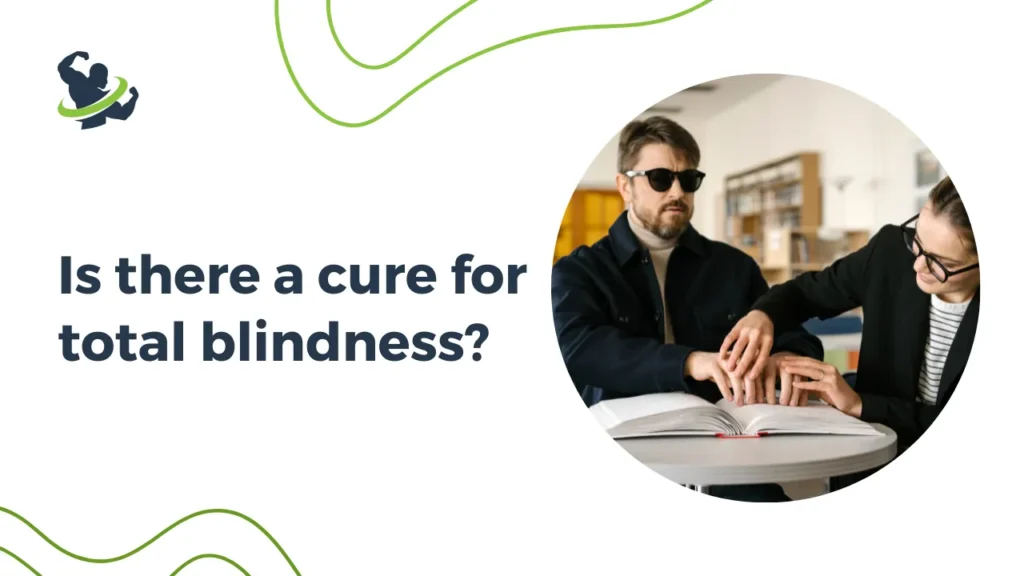
Is there a cure for total blindness? : The inability to see light. But in reality very few people have this condition. Yet many people are unable to compete or earn a living because of low vision.
Today around two million people around the world are completely blind. As per the latest statistics in India, 90 lakh people are totally blind and another 4.50 crore people are partially blind. Cataracts are especially common among eye diseases. Fortunately it is a treatable disease. This disease, which usually occurs with age, can be corrected with surgery and the person can see later. But India does not have enough ophthalmologists to perform cataract surgeries for 5 million people and the number is increasing every year. Friends, in this article we will tell you Is there a cure for total blindness?
Conjunctivitis and chicken pox cause whitening and opacity. The vision of such patients can be restored by corneal transplantation surgery (keratoplasty), but it requires specialist surgery, good equipment and most importantly eye donation. Blindness caused by lack of food can also be prevented by taking timely measures. Blindness from other causes is usually not curable. Thus blindness is a complex question. Research is going on to overcome this.
Based on this blindness is divided into two categories:
- A person who cannot count fingers from a distance of more than three meters from the better eye is considered to be totally blind.
- A person who cannot read the uppermost capital letter in the better eye of the Snellen chart i.e. 6/60 or who has a visual field of less than the middle 200 is considered economically blind. Such persons can compete, but cannot earn their living.
Is there a cure for total blindness?
When a person’s vision deteriorates and cannot be treated with astigmatism or the use of contact lenses, the condition is known as blindness. Friends we tell you Is there a cure for total blindness? Will tell about it, before that you should know a little about blindness.
The National Program for Control of Blindness (NPCB) categorizes blindness based on the following criteria:
- the inability to count a person’s fingers 6 meters or 20 feet away (in technical terms)
- distance vision 6/60 or better while wearing glasses
- loss of visual acuity at 20 feet or less
- Partial vision or low vision – where the vision is at a low level.
- Severe visual loss (blindness) – in which visual acuity is severely impaired, resulting in the impossibility of movement dependent on visual acuity.
Types of Blindness – Is there a cure for total blindness?
Friends, let us see some types of blindness, later we can see whether total blindness can be cured? Will talk about it in great detail.
- Economic blindness: In general technical language a person is unable to count fingers from a distance of 6 meters or 20 feet.
- Social blindness: to see at or around 3/60
- Manifest blindness: inability to see light at 1/60 power
- Total blindness: Not being able to see even the light of a battery.
- Treatable blindness: This type of blindness can be managed by treating the cataract.
- Preventable blindness: Various conditions of blindness such as xerophthalmia, trachoma and glaucoma are preventable and can be completely prevented with certain measures or preventive measures.
- Preventable Blindness: Preventable or curable blindness is commonly known as preventable blindness.
Causes of Blindness – Is there a cure for total blindness?

Friends, we have seen the types of blindness, but now we will talk to you about its causes and in the end we will tell you that Is there a cure for total blindness? So friends, first talk about its reasons.
Many conditions can be responsible for blindness which cause blindness such as:
- Acute causes of blindness include cataracts, xerophthalmia, macular degeneration, trachoma, infantile blindness, and diabetic retinopathy.
- Cataract disease causes opacity of the lens in the eyes. Apart from this, in many severe cases white reflection is seen in the eyes. The most important symptom of this disease is blurred vision without pain.
- The eyes do not depend on the retina for light rays to enter, the retina is the part of the eye where images are formed, its layers appear together with defects. It plays an important role in children’s vision.
- Glaucoma occurs when there is an increase in the load on the eyes. Due to the development of this load, there is a possibility of damage to the eyes. Therefore, the disease should be recognized early and properly diagnosed as eye conditions caused by this disease can be treated.
- The cornea is the transparent glass-like part of the eye that is visible at the front. The cornea lets light rays enter the eye. The corneal defect can cause considerable difficulty for the patient to see.
- Cataracts can cause blurred vision and cause more flicker.
- Diabetes can cause blurred vision. Stinging of the eyes or difficulty seeing at night can cause difficulty in many cases.
- Zamar can cause nearsightedness, farsightedness, and visual loss.
- In macular degeneration, the field of vision is within a limited range, although the core ability to see is gradually lost.
Diagnosis of Blindness – Is there a cure for total blindness?
Friends, we told you about the causes and types of blindness, but now we are with you, Is there a cure for total blindness? Let’s discuss about it.
When a person sees less (blurred) it can be measured from the visual angle of two points.
- Acuity: This is the ability to see centrally. It is used for distant objects such as reading a book or watching TV.
- Field of vision: The ability to see around the field of vision when you look ahead is called the field of vision.
- During visual field testing, a person is asked to look forward at a device. When a flash of light hits peripheral vision, the person is asked to press a button every time they see the light.
- Snellen charts are used to measure visual acuity. This test consists of reading the words written on the chart.
- These words are written from uppercase to lowercase letters. This chart is used daily during eye exams. After this test a number is given by getting two marks. Demonstrates the ability to successfully read numbers from a distance before the words written on a number chart.
- So if you have 6/60 distance vision, that means you can only read from 6 meters away. A person with healthy vision can read from 60 meters away. Normal visual acuity is 6/6.
Partial visual impairment or visual impairment is specifically divided into:
- Very low visual acuity (3/60 to 6/60) but visual acuity is completely lost.
- A combination of moderate visual acuity (above 6/24) or blurred vision may appear.
- There is full visual acuity (above 6/18), but your entire field of vision is lost.
Severe visual loss is defined in the term (blindness) in which a person becomes so blind that he cannot do any of his work. He doesn’t have enough vision. Blindness can occur especially when one of the three categories is affected.
- There may be extremely poor visual acuity (less than 3/60), but visual acuity remains perfect.
- There may be poor visual acuity (between 3/60 and 6/60), but your field of vision may be severely reduced.
- There may be average visual acuity (3/60 or better) but the field of vision may be severely reduced.
- Blindness due to inadequate nutrition: This type of blindness can be treated by changing the diet.
- Difficulty in seeing due to refractive error: This problem can be treated by correcting the refractive error and wearing suitable glasses.
- Blindness due to infection or inflammation: This type of blindness can be treated with medicine in the form of drops or pills.
- Most people become blind due to cataract: In such patients, cataract surgery is performed. In most cases, patients regain their sight. Specifically, the opaque natural lens is removed and an intraocular lens (IOL) is implanted in the eye.
conclusion
Friends, in this article we have told you that Is there a cure for total blindness? And also told about their types, causes and diagnosis. Friends, if someone in your family or friends has the problem of blindness, then you can share this information with him. Thank you.
